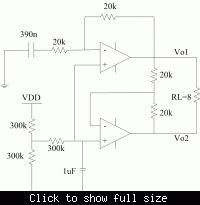walker5678
Full Member level 3
the diagram is an audio amplifier system which use BTL connection method.
If there is 217Hz ripple on the VDD, then the positive input terminal of the two amplifiers will also has ripple, which will induce the differential output voltage on Vo1 and Vo2.
How to improve the PSRR performance that makes Vo1-Vo2 minimum when there is 217Hz VDD ripple? except to increase the 1uF capacitor. ( the audio input terminal was short to ground for testing PSRR)

If there is 217Hz ripple on the VDD, then the positive input terminal of the two amplifiers will also has ripple, which will induce the differential output voltage on Vo1 and Vo2.
How to improve the PSRR performance that makes Vo1-Vo2 minimum when there is 217Hz VDD ripple? except to increase the 1uF capacitor. ( the audio input terminal was short to ground for testing PSRR)

Last edited by a moderator: